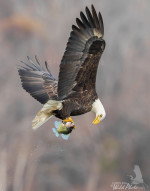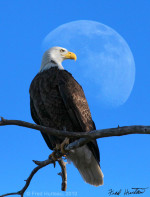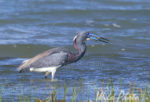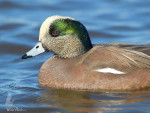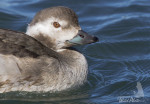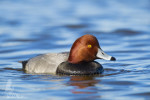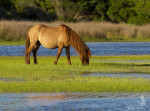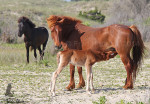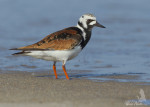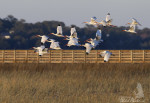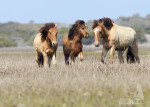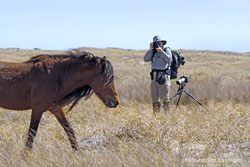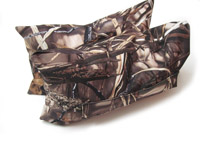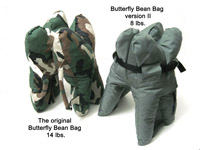Part 3 – Return to Rachel Carson Reserve and Shackleford Banks
by admin on Dec.16, 2021, under Locations
I’ll pick up my story from the previous post as we’re leaving Cape Lookout at midday after a successful morning of horse photography on Shackleford Banks. We made our way across Back Sound behind Shackleford aboard the “Calico Jack II”, with Capt. Monty of Seavisions Charters, headed for Rachel Carson Reserve. The sunny weather was beautiful, with calm wind and flat, glassy water, and temps close to 70 degrees. You couldn’t ask for a nicer December day.
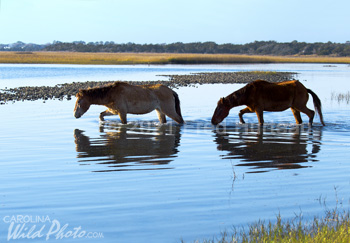
When we reached the reserve, we spent over an hour checking out several areas of the reserve where we had found the horses the day before, but no luck. Finally we decided to check out the tidal flats on the ocean side of the reserve, despite them not being there the day before. Sure enough, we found the horses on the ocean side of the reserve, out feeding on the tidal flats, right where we would normally have expected to find them in good weather this time of day.
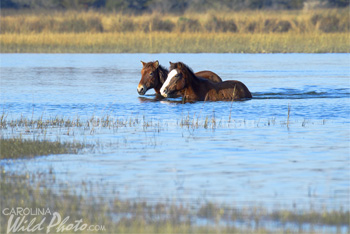 As we arrived though, they began heading westward across a deep channel in the marsh, looking for more fresh grass. The tide was up, and it was too deep for us to wade and follow them, so we took the boat west to land and wait for them on the other side of the channel. We hopped out of the boat and carefully made our way through the slippery marsh muck, taking up positions to capture the horses as they waded and swam across by ones and twos. This made it easy to concentrate on photographing just one or two horses at a time as they crossed the channel.
As we arrived though, they began heading westward across a deep channel in the marsh, looking for more fresh grass. The tide was up, and it was too deep for us to wade and follow them, so we took the boat west to land and wait for them on the other side of the channel. We hopped out of the boat and carefully made our way through the slippery marsh muck, taking up positions to capture the horses as they waded and swam across by ones and twos. This made it easy to concentrate on photographing just one or two horses at a time as they crossed the channel.
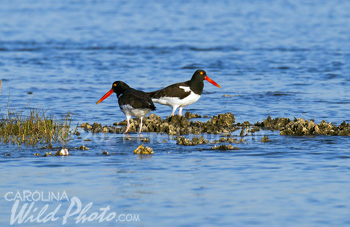 But before they all were across and settled in again to feed, a pair of noisy American Oystercatchers flew in, landing just thirty yards away from us, whistling their harsh calls back and forth to each other. This drew our attention away from the horses as we tried to also get some photos of these striking birds. They appeared almost clownish with their long, flourescent-looking red-orange bills that clashed with their otherwise simple black and white bodies, and accented by school bus yellow eyes ringed with the same brilliant red-orange. There is no way you can mistake the identity of this bird species.
But before they all were across and settled in again to feed, a pair of noisy American Oystercatchers flew in, landing just thirty yards away from us, whistling their harsh calls back and forth to each other. This drew our attention away from the horses as we tried to also get some photos of these striking birds. They appeared almost clownish with their long, flourescent-looking red-orange bills that clashed with their otherwise simple black and white bodies, and accented by school bus yellow eyes ringed with the same brilliant red-orange. There is no way you can mistake the identity of this bird species.
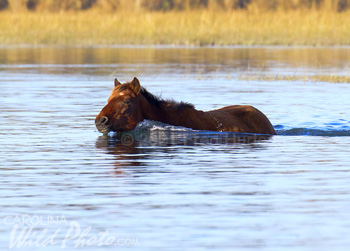
I captured a few shots of the Oystercatchers from a distance before I managed to frighten them away by failing to follow my own rules about approaching birds in the open. With only a 400mm reach, I pressed in too closely without stopping to take shots as I went, to insure I got some photos along the way before they scattered. In the end I had to settle for what I had.
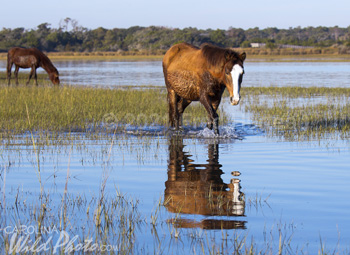 A few closer bird shots would have been nice, but the horses weren’t waiting for me either, as they continued to tread water to reach the new grazing spot. By now though it was after 4:00 pm, and the sun was getting low. It gave us that seemingly magical light, often referred to as the Golden Hour, so we made the most of the time left. With the water so calm and flat, we had mirror reflections to work with, which always adds an appealing dimension to wildlife photos. We worked the lighting as long as we could, but too soon it was time to call it a day.
A few closer bird shots would have been nice, but the horses weren’t waiting for me either, as they continued to tread water to reach the new grazing spot. By now though it was after 4:00 pm, and the sun was getting low. It gave us that seemingly magical light, often referred to as the Golden Hour, so we made the most of the time left. With the water so calm and flat, we had mirror reflections to work with, which always adds an appealing dimension to wildlife photos. We worked the lighting as long as we could, but too soon it was time to call it a day.
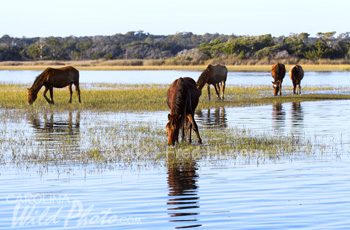
We took in a nice sunset as we headed back to the dock, knowing there would be one more afternoon of wild horse photography to enjoy on this three day adventure. The next day was forecast to be warm and sunny, but also a bit windy, so we planned to keep to the Rachel Carson Reserve for Part 4 – Return to Rachel Carson Reserve and Shackleford Banks.
 This blog is an extension of the
This blog is an extension of the 